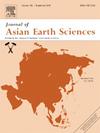The role of magma mixing in generating the Eocene potassic quartz syenite and mafic microgranular enclaves in the Ailao Shan–Red River shear zone, SW China: Insights from in situ Sr isotopes of plagioclase
IF 2.7
3区 地球科学
Q2 GEOSCIENCES, MULTIDISCIPLINARY
引用次数: 0
Abstract
Understanding the origins of potassic rocks and mafic microgranular enclaves (MMEs) can provide important information for revealing their petrogenesis and regional tectonic evolution. We studied the Shilicun quartz syenite and MME and their plagioclases to elucidate their origins and investigate crust–mantle interactions in the southern Ailao Shan–Red River (ASRR) shear zone. Zircon U–Pb ages indicate the coeval formation of the quartz syenite and MME during the Eocene (approximately 35 Ma). The MMEs exhibit spheroidal shapes and contain acicular apatites, indicating that they represent globules of the coeval mafic melt injected into and partly assimilated by the felsic magmas. They are characterized by high contents of MgO (2.9–5.1 wt%), Ni (90–172 ppm), and Cr (105–180 ppm), as well as high Ba–Sr contents. The MME samples yield εHf(t) values of –2.2 to + 0.5 and εNd(t) values of –5.7 to –6.4, with high (87Sr/86Sr)i ratios of 0.70734–0.70758. These features suggest that they were derived from metasomatized enriched lithospheric mantle. The quartz syenites are characterized by high SiO2 (68.5–69.0 wt%) and Al2O3 (15.6–16.2 wt%) contents, Sr/Y ratios (40.6–73.3), and low MgO, Cr, and Ni contents, as well as low Mg# values. They have a low (87Sr/86Sr)i ratio of 0.70716 and an εNd(t) value of –4.5. Type I plagioclase from the quartz syenite exhibits reverse zoning and shows sieve textures and resorption surfaces in the core, indicative of rapid cooling and disequilibrium mixing between mafic and felsic magmas. It has significantly different (87Sr/86Sr)i ratios (0.70666–0.70726) among the core (0.70666–0.70674), mantle (0.70692–0.70726), and rim (0.70714–0.70715), with the An content increasing from the core (An10–13) to the mantle (An14–15) and then decreasing to the rim (An9–10). Type II plagioclase exhibits a normal zoning texture, with the An content decreasing from the core (An13–15) to the rim (An12–13). It has a small variation in (87Sr/86Sr)i ratios from 0.70708 in the core to 0.70722 at the rim. Type III plagioclase from the MME is normally zoned and has high (87Sr/86Sr)i ratios of 0.70719–0.70742, with the An content decreasing from the core (An17) to the rim (An8). The large variations in the Sr isotopes of different types of plagioclases record magma mixing processes. Therefore, we suggest that the quartz syenites were formed by partial melting of thickened lower crust, with the involvement of mantle-derived melts that are characterized by high (87Sr/86Sr)i ratios. We propose that partial removal of the lower continental lithospheric mantle induced asthenosphere upwelling, which triggered partial melting of the residual metasomatized lithospheric mantle. These mantle-derived magmas provide heat and material for the partial melting of thickened lower crust and ultimately generate diverse potassic rocks along the ASRR shear zone.

求助全文
约1分钟内获得全文
求助全文
来源期刊

Journal of Asian Earth Sciences
地学-地球科学综合
CiteScore
5.90
自引率
10.00%
发文量
324
审稿时长
71 days
期刊介绍:
Journal of Asian Earth Sciences has an open access mirror journal Journal of Asian Earth Sciences: X, sharing the same aims and scope, editorial team, submission system and rigorous peer review.
The Journal of Asian Earth Sciences is an international interdisciplinary journal devoted to all aspects of research related to the solid Earth Sciences of Asia. The Journal publishes high quality, peer-reviewed scientific papers on the regional geology, tectonics, geochemistry and geophysics of Asia. It will be devoted primarily to research papers but short communications relating to new developments of broad interest, reviews and book reviews will also be included. Papers must have international appeal and should present work of more than local significance.
The scope includes deep processes of the Asian continent and its adjacent oceans; seismology and earthquakes; orogeny, magmatism, metamorphism and volcanism; growth, deformation and destruction of the Asian crust; crust-mantle interaction; evolution of life (early life, biostratigraphy, biogeography and mass-extinction); fluids, fluxes and reservoirs of mineral and energy resources; surface processes (weathering, erosion, transport and deposition of sediments) and resulting geomorphology; and the response of the Earth to global climate change as viewed within the Asian continent and surrounding oceans.
 求助内容:
求助内容: 应助结果提醒方式:
应助结果提醒方式:


